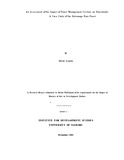| dc.description.abstract | For many years forests have been mainly exploited as sources of timber and their climatic
functions. Yet forests present opportunities for additional numerous uses. More recently,
forests are increasingly gaining appreciation as important sources of livelihood options to
forest adjacent communities in their daily lives. However, there are a number of factors
that impact on the utilization of forests by local communities. Key among them is the
forest management system which impacts on the local community by either encouraging
or discouraging use of the forests.
Kakamega forest is one of the four remaining indigenous forests in Kenya. The forest
neighbours constituencies that experience high poverty levels, despite it's potential to
impact positively to households incomes. This observation inspired and results in this
research project. The study set out to assess the impact of the current forest management
of Kakamega Rain Forest on households. The study was conducted in Shinyalu
constituency, Kakamega District. Face to Face interviews were conducted within the
local community using a structured questionnaire. In-depth interviews were also
conducted with key informants using a discussion schedule.
4>
-.
Findings from the study reveal that the government solely manages the forest through the
Forest Department. Like all other forests, Kakamega forest was placed under the
stewardship of the government during the colonial era when formal forest management
systems were implemented. This system led to the eviction of communities from the
forest and excluded them from the forest's management. ,
IX
Formal rules and regulations were developed to guide and control the communities'
access and use of the forest under law enforcement with punitive measures such as
penalties and fines being charged for those that did not follow the rules. At the time of
the study, the Forest Department-was in the process of changing this management system
with the main focus being inclusion of local communities to forest's management.
The study found that though the community could access and use the forest resources,
utilization of those resources was mainly limited by two issues; the laws and legislation
enforced regarding usage of the forest's resources limited the extent to which the
community can utilize the products and secondly; the community has not transformed the
products they utilize from the forest into potential income sources thus the benefits that
are derived from the forest remain minimal. The community was also found to have
inadequate use of the forest. For instance, the community only focused on using products
and did not utilize the potential opportunities that services from the forest could provide,
for instance, tourism and camping.
This research study concluded that far the forest to impact on local communities
households, there is need for value addition to the ~ducts collected to enhance their
competitiveness for trade, additional forest products and services need to be investigated
and their potential to contribute to households assessed. The study recommends that all
the forest stakeholders should partner up to chart a way forward on the possible
opportunities that the forest provides for local communities and how these opportunities
can be translated into positive impacts on households increasing the household wealth
which could result into the possible reduction of the high poverty levels experienced by
the local community. | en |

